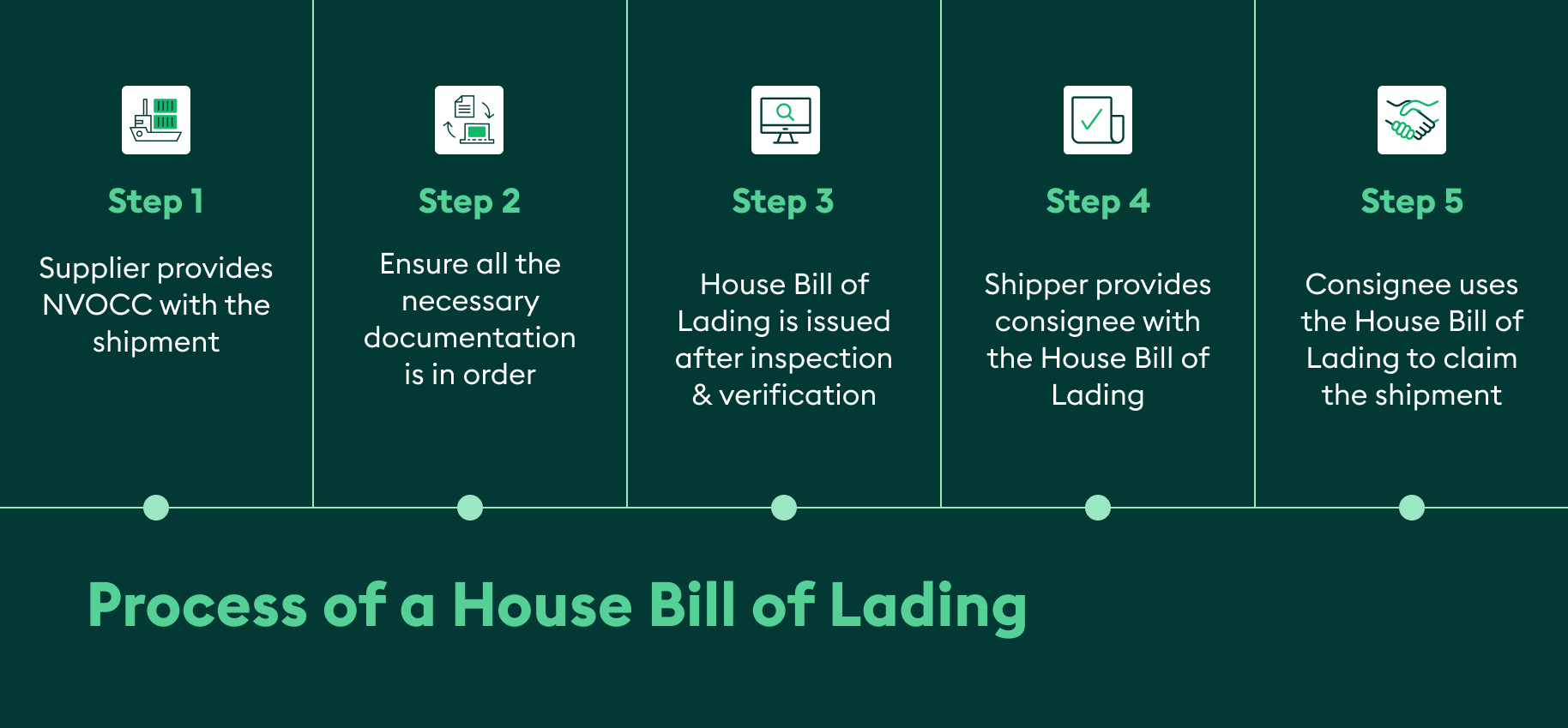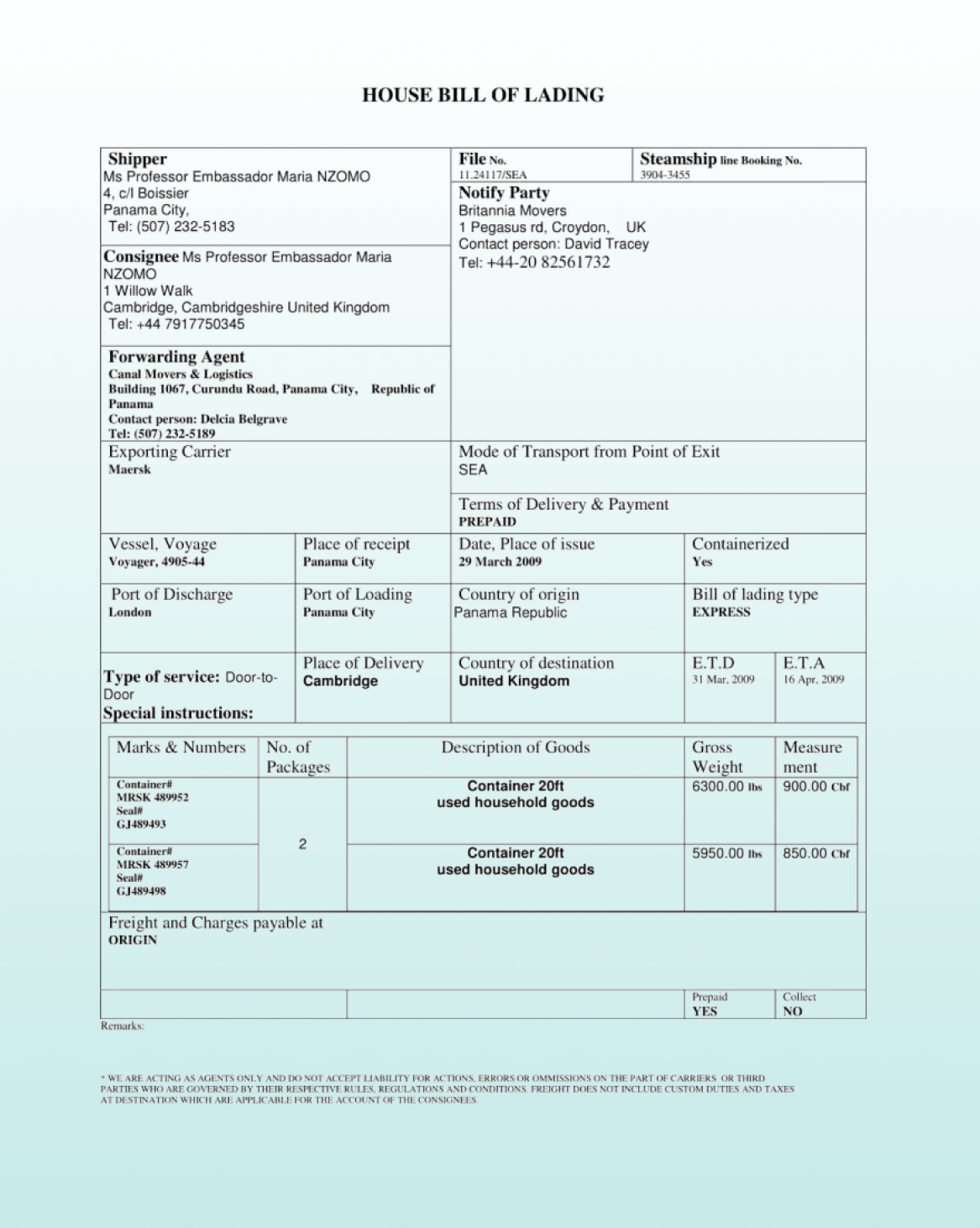A House Bill of Lading is a crucial document within the shipping industry. Without it, you’ll face a myriad of challenges such as non-compliance with regulations and lack of proof of ownership. In this blog, we’ll explore the various nuances of the HBL and help you streamline and keep your shipping documentsWhat are shipping documents? In shipping, shipping documents are documents that provide information about the goods being shipped. They may include information such as the origin and destination of th... More in one place on xChange.
When working in the shipping industry, execution is critical in all aspects of the shipping process. From loading the cargo right down to delivery, you need to make sure that everything runs as smoothly as possible. This is when a House Bill of Lading holds great significance.
For example, if you’re the owner of an import-export business and you receive an order for leather to be shipped to Japan, you’ll need a House Bill of Lading. This document not only proves ownership of the cargo but also outlines important details of your shipment. The freight forwarder needs this as they are the ones responsible for inspecting and delivering your cargo.
If this document goes missing, or you happen to misplace it, you won’t be able to send out your shipment. However, if you were able to keep your House Bill of Lading secure and online, you wouldn’t need to worry about delayed shipments. This is where Container xChange comes in.
Our platform is 100% online, so you can handle all your business operations from the comfort of your phone or laptop screen. Using our API-Integrated software, you can store all of your shipping documentsWhat are shipping documents? In shipping, shipping documents are documents that provide information about the goods being shipped. They may include information such as the origin and destination of th... More online and in one place. This way, you reduce the risk of losing or forgetting any important paperwork. You can also track your shipment in near real time by using your Bill of Lading number. So you stay informed and can act fast if you run into any speed bumps along the way. Sounds good? Then click on the banner below and join the digital revolution that is xChange!
What is the meaning of House Bill of Lading?
A House Bill of Lading is a document typically issued by a freight forwarder or a non-vessel operating common carrier (NVOCC) to a shipper. This document acknowledges the receipt of the shipment items. It serves as a contract, a receipt, and a title shipping document for the goods being transported. The HBL outlines the terms and conditions of the shipment and contains essential information about the cargo, the parties involved, and the journey of the goods.
There’s a method as to how an HBL works, so let’s run through it step by step:
House Bill of Lading: how does it work?
The process of container shipments requires a lot of documentation and can sometimes become overwhelming. Especially if you’re unaware of how each of them works, and how they tie in together. Below is a step-by-step breakdown of how a House Bill of Lading works while still using the example from the beginning of the blog:
| Step 1: Supplier provides freight forwarder/ NVOCC with the shipment | The supplier hands over the shipment to you. |
| Step 2: Ensure all the necessary documentation is in order | Before proceeding with the shipment, you must ensure that all required shipping documentsWhat are shipping documents? In shipping, shipping documents are documents that provide information about the goods being shipped. They may include information such as the origin and destination of th... More are complete and accurate. This includes verifying that you’ve provided accurate details about the goods. |
| Step 3: House Bill of Lading is issued after inspection & verification | Once you receive and confirm your goods, an inspection and verification process takes place. This is to ensure that the goods match the description you’ve provided. After this verification, they issue the House Bill of Lading. |
| Step 4: Shipper provides consigneeWhat is a consignee? When transporting freight (by ocean, air, or land), there are two parties involved — one who is shipping and the other who is receiving the freight. The recipient of the goods b... More with the House Bill of Lading | The shipper then provides the consigneeWhat is a consignee? When transporting freight (by ocean, air, or land), there are two parties involved — one who is shipping and the other who is receiving the freight. The recipient of the goods b... More with the HBL. They need this document to claim the goods upon arrival. |
| Step 5: ConsigneeWhat is a consignee? When transporting freight (by ocean, air, or land), there are two parties involved — one who is shipping and the other who is receiving the freight. The recipient of the goods b... More uses the House Bill of Lading to claim the shipment | Upon arrival at the destination port, the consigneeWhat is a consignee? When transporting freight (by ocean, air, or land), there are two parties involved — one who is shipping and the other who is receiving the freight. The recipient of the goods b... More presents the House Bill of Lading to the customs or port officials. This document is crucial for customs clearance, as it provides important information about the leather being imported. Once the customs clearance process is completed, the consigneeWhat is a consignee? When transporting freight (by ocean, air, or land), there are two parties involved — one who is shipping and the other who is receiving the freight. The recipient of the goods b... More can take possession of the goods and proceed with the delivery. |
And viola! You have a successful shipment. Knowing these steps helps ease the process and avoid confusion. It’s simple and easy to understand.

What is the purpose of a House Bill of Lading?
The main purpose of a House Bill of Lading is to outline the contract of carriage between the shipper and consigneeWhat is a consignee? When transporting freight (by ocean, air, or land), there are two parties involved — one who is shipping and the other who is receiving the freight. The recipient of the goods b... More. It represents ownership of the goods and ensures that customs clearance runs smoothly. Additionally, the HBL includes container tracking and establishing liability in case of damage.
A House bill of Lading can often be confused with a Master Bill of Lading. Both documents contain the same detailed information about the cargo, such as the number of containers, seal numbers, weight, measurements, etc.
It’s important to know their meanings, as well as how they differ in order to ensure an easy shipping process. Let’s explore this in depth:
Master Bill of Lading
The ship owner or operator, also known as the carrier, usually issues a Master Bill of Lading (MBL). It serves as a contract of carriage between shipper and carrier. The shipper only receives the MBL if they’re working directly with the carrier or freight forwarder. This document is vital as it confirms that the carrier received that expensive leather you were shipping to Japan.
Did you know? You can track your shipment by using your Bill of Lading number. However, it’s often a waste of time switching between different tracking sites. These sites don’t always provide you with accurate information. The good news is that Container xChange helps you avoid that problem. Our platform allows you to digitally track your shipment in near real time using your Bill of Lading number. This way, you stay informed and can act ahead in case of any mishaps that could cause loss of revenue to your business.
Click the banner below to one of our experts today and they’ll take you through the process of tracking your shipment easily and efficiently!
What’s the difference between House Bill of Lading and Master Bill of Lading?
Now, moving on to the difference between these two Bills of Lading; there are subtle but key aspects that set them apart:
| House Bill of Lading | Master Bill of Lading |
| Usually issued by NVOCC or Freight Forwarder | Issued by Carrier or Ship owner |
| Represents the contract between Shipper and ConsigneeWhat is a consignee? When transporting freight (by ocean, air, or land), there are two parties involved — one who is shipping and the other who is receiving the freight. The recipient of the goods b... More | Represents the contract between Shipper and Carrier |
| Can be negotiable | Often times non-negotiable |
In short, the main difference lies in their scope and recipients. The ocean carrier issues the MBL to the NVOCC or freight forwarder, covering the entire consolidated shipment. The NVOCC or freight forwarder issues the HBL to individual shippers for each specific shipment. Both documents play vital roles in coordinating, tracking, and facilitating the movement of goods in shipping.
How to track House Bill of Lading on Container xChange
Now that you’re aware of the key differences between these two bills of lading, let’s see how keeping them digitally secure helps you streamline your container operations on the Container xChange platform.
We are a 100% digital marketplace for buying, selling and leasing containers. But it doesn’t end there; we also offer special features such as:
- xChange Insights where you can keep track of container availability and price in 180 locations globally
- xChange Wallet where you’re able to handle all your financial operations safely
- Insurance so that your cover your assets accordingly
- Tracking through API systems which allows you to track your shipment using your bill of lading number
This is just to name a few of the benefits you receive when you become part of the xChange family. Our API tracking software makes it easy for you to store and access paperwork such as a House Bill of Lading. Here, you’ll also be able to track your shipment by using the unique Bill of Lading number. So, if you’re ready to welcome the world of shipping digitalization into your business, then speak to one of our informed experts and see how you can do this in a few easy steps!
House Bill of Lading: Format and contents
It’s important to note that each shipping container companies will ultimately have its own format for a House Bill of Lading. However, the details that need to be filled in are identical. Here’s what you can find on a House Bill of lading:
- Shipper’s Information – Name, address, and contact details of shipper
- Consignee’s Information – Name, address, and contact details of consigneeWhat is a consignee? When transporting freight (by ocean, air, or land), there are two parties involved — one who is shipping and the other who is receiving the freight. The recipient of the goods b... More
- Notify Party – Details of any third party to be notified about the shipment’s arrival or delivery
- Carrier’s Information – Name, logo, and contact details of the carrier
- Voyage and Port Details – Vessel name, voyage number, departure and destination port, and expected arrival dates.
- Description of Goods – Detailed description of the goods being shipped, including quantity, weight, measurements, and any special handling instructions.
- Marks and Numbers – Identification marks and container number
- Freight Charges – Agreed upon freight charges and surcharges
- Terms and Conditions – Terms and conditions of contract such as liability and insurance.
- Declaration and Signature – The declaration of the shipper confirming the accuracy of the provided information
- Date of Issue – Date when the H/BoL is issued
- Bill of Lading Number – A unique reference number assigned to the HBL for tracking purposes
- Governing Law – These laws resolve disputes related to the HBL.
- Signature and Seal – The signature and seal of the issuing carrier or its authorized agent
Below is an example of what a House Bill of Lading might look like:

Keep your House Bill of Lading digitally secure on Container xChange
And that’s a wrap on the crucial House Bill of Lading. Now let’s circle back to how you benefit most from the Container xChange platform.
Container xChange is a platform that is revolutionizing the shipping logistics industry.
Container xChange is a seamless and transparent platform that brings the power of digital innovation to the heart of container management. It gives you access to a range of benefits that align perfectly with your shipping needs.
Our platform offers 50k+ containers for your various cargo needs, from a list of 1500+ vetted suppliers across 2500 locations worldwide. You can rest assured to find a box that suits your requirements and budget with ease.
If you want to track your shipment xChange makes this easy; with our container tracking systems you can track your container movement anytime and from anywhere, effortlessly.
Leverage the digital solution we have designed for you and let your business operations sail smoothly. Join the Container xChange family today and enjoy every benefit under one roof. Click the banner below and change how you manage your container operations through this innovative approach!
House Bill of Lading: Common FAQs
What is the house bill of lading?
The House Bill of Lading (HBL) is a shipping document issued by a freight forwarder or NVOCC to individual shippers, detailing shipment terms, contents, and parties involved.
What is the difference between a house bill of lading and master bill of lading?
A House Bill of Lading (HBL) covers individual shipments within a consolidated container, issued by a freight forwarder to shippers whereas a Master Bill of Lading (MBL) covers the entire consolidated shipment, issued by the ocean carrier to the freight forwarder or NVOCC.
What is the difference between house bill of lading and bill of lading?
The House Bill of Lading is issued by a freight forwarder or NVOCC to individual shippers and pertains to their specific shipments; a Bill of Lading can refer to either the House BoL or Master BoL, serving as a legal contract and receipt for goods in shipping.
What happens if there is an error in a house bill of lading?
Errors in a House Bill of Lading can lead to complications such as customs issues, incorrect delivery, or disputes; prompt correction through the issuing party is necessary to avoid potential disruptions in the shipping process.




